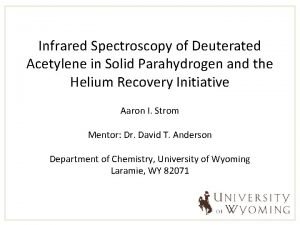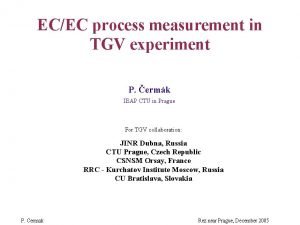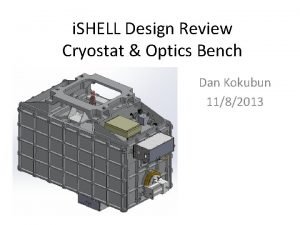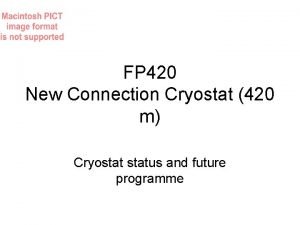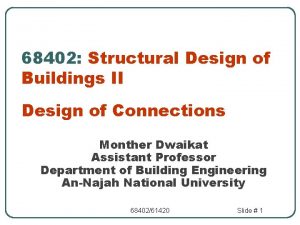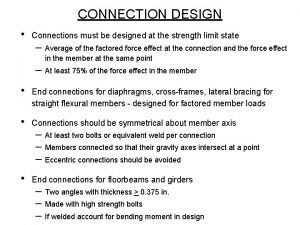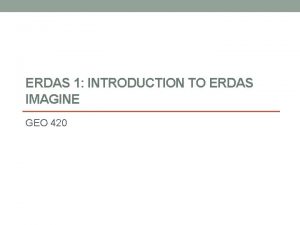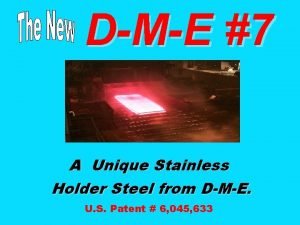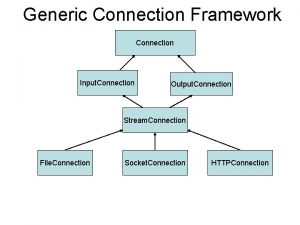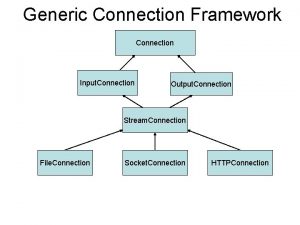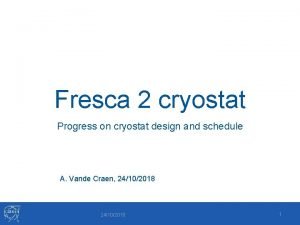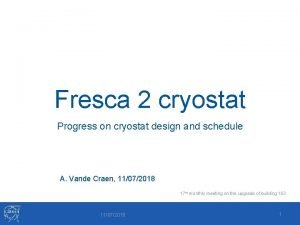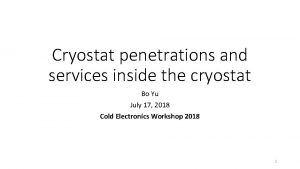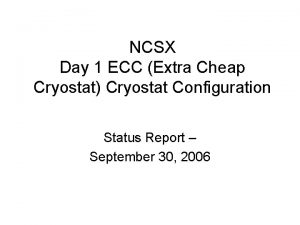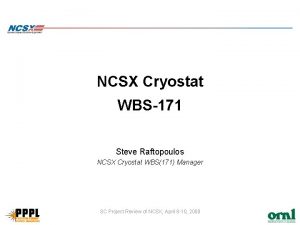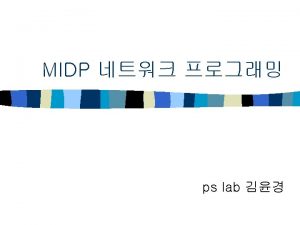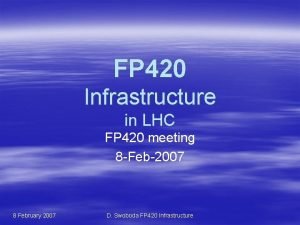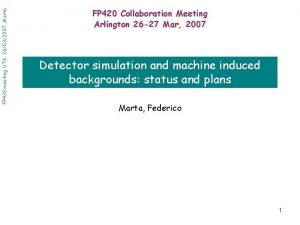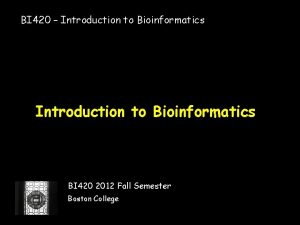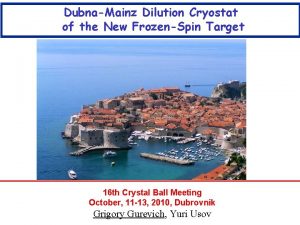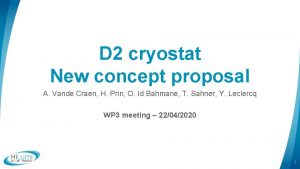FP 420 New Connection Cryostat 420 m Cryostatus


















- Slides: 18

FP 420 New Connection Cryostat (420 m) Cryostatus and future programme

New Connection Cryostat (NCC) Approx 14 m long. Assembled on the surface and installed as a single piece. The detectors will be mounted on a mechanically independent platform bolted to the tunnel floor

The New Connection Cryostat (NCC) is registered as a EUCLID three dimensional drawing in CDD (CERN Drawing Directory) - drawn by Thierry Renaglia of the CERN TS/MME design office Will in future be available in CATIA

Cross-section of the NCC X-line He. II heat-exchanger Cryo & electrical by-pass cryostat Beampipes

Modified Arc Termination Modules at each end of the NCC In order to give clear a the detectors the x-lin displaced horizontally dogleg introduced in t at each end

NCC Design - next steps • Pre-design complete and accepted by the collaboration. • Thierry Renaglia in the design office has already completed many details and will discuss them in a working group convened by Vittorio Parma. • AT Department (LHC magnets, cryogenics and vacuum) have agreed to work on the cryostat even though FP 420 is not an “approved expt”.

Engineering Change Request (ECR) • Once the design has advanced far enough to allow a reliable cryogenic and electrical performance analysis the WG will prepare an ECR. • The ECR will then be sent formal approval to all the LHC project engineers and finally the LHC Project Leader • Hopefully this will be around the same time as CERN Research Board approval

Previous slide refers to the NCC only • Note that a similar, but separate ECR type process will have to follow for the Hamburg beampipe together with the beam vacuum performance, RF effects and other beam operational aspects. • This must be taken very seriously if the 420 m (and 220 m) detectors are going to be accepted and allowed to operate at Luminosity = 1034 cm-2. s-1 This will be a major topic in future TIM meetings if the Collaboration agrees

NCC support beams with slots for near electronics Vertical slots (68 x 600 mm) can be introduced into the support beams for near electronics, but care must be taken to avoid an unacceptable reduction of rigidity. Note that there is no ‘transport space’ left for access from the side.

Radiation shielding proposal by Domenico Dattola to limit the radiation dose in the tunnel. The existing connection cryostats have similar lead plates within the cryostat. Mobile shielding, sliding along the support rails on the cryostat to provide easy access to the moving beam-pipe and detector stations Fixed shielding around the two beam-pipes.

Inter. Connection Cryostats Introduction on ICCs

Inter. Connection Cryostats Introduction on ICCs MARIC 06/02/2008

Inter. Connection Cryostats Opening in L 8 MARIC 06/02/2008

Interconnection Cryostats MARIC 06/02/2008

Inter. Connection Cryostats MARIC 06/02/2008 A Poncet

Inter. Connection Cryostats MARIC 06/02/2008 A Poncet

Inter. Connection Cryostats Intervention steps : Duration estimates are aggressive 1. 2. 3. 4. 5. 6. 7. 8. 9. Warm-up of the concerned subsectors and cooldown put in stand-by (for cold sectors) : 2 -3 days Vent the concerned subsectors (for pumped vacsec) : 1/2 day in parallel Take geometrical reference measurement (to validate the first ones only ? ) : ½ day Open cryostat – Remove thermal shielding – open shuffling module : 4 shifts - 2 days [Reduced to 1. 5 days after learning] Reinforce insulation – Perform electrical test : 2 extended days [Reduced to 1. 5 days after learning] Reclose shuffling module, leak test, radiographic inspection : 4 shifts – 2 days Remount MLI and thermal shield - close cryostat : 3 shifts – 1. 5 days Repump and leak test : 5 days Reconditioning for cryo : 3 days in parallel MARIC 06/02/2008

Inter. Connection Cryostats Summary conclusions : Additional tooling is under procurement Raw material is ordered for the beginning of the production Start of one intervention every 3 days Shifts and extended days required Overall schedule worked out with TS/ICC (K Foraz) for intervention on all sectors but 5 -6 (and 4 -5) 6. Solutions is validated for quadrupole BB, to be validated for dipole BB and to be finalised for lyras 7. Opening in R 7 will confirm/infirm the systematic aspect of the defect ; IF NOT, the strategy will need to be adapted 8. Plan is to complete 7 -8 for end of next week. 9. This fast reaction was possible thanks to the availability and competence of experienced technical staff : - A Bastard, M Duret, D Etiembre, JM Hubert, M Pozzobon, S Triquet, CERN staff - G Favre, M Jamain, O Mastel, G Maury, FSU - Ph de Souza, IEG - P Borowiec, L Hajduk, ICIT + VAC, MEL, CRG 1. 2. 3. 4. 5. MARIC 06/02/2008
 Cryostat procedure
Cryostat procedure Cryostat processing
Cryostat processing Cryostat
Cryostat Cryostat
Cryostat Cryostatus
Cryostatus A325sc bolts
A325sc bolts Slip critical connection vs bearing connection
Slip critical connection vs bearing connection Image into text
Image into text Slip critical connection vs bearing connection
Slip critical connection vs bearing connection Rosenberger hvs 240
Rosenberger hvs 240 Csci 420
Csci 420 Erdas imagine
Erdas imagine Resolucion 420/2011
Resolucion 420/2011 Envee 420
Envee 420 Mini metric olympics worksheets answers
Mini metric olympics worksheets answers Hardenable 420 f
Hardenable 420 f 420 pst
420 pst Why study operations management
Why study operations management Factor tree of 90
Factor tree of 90
